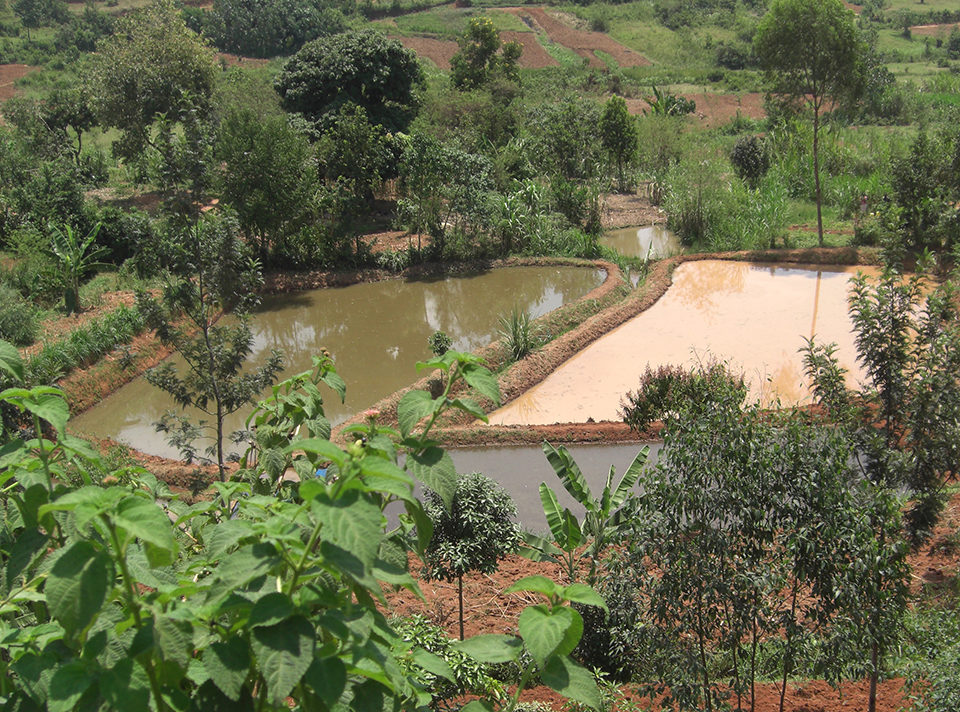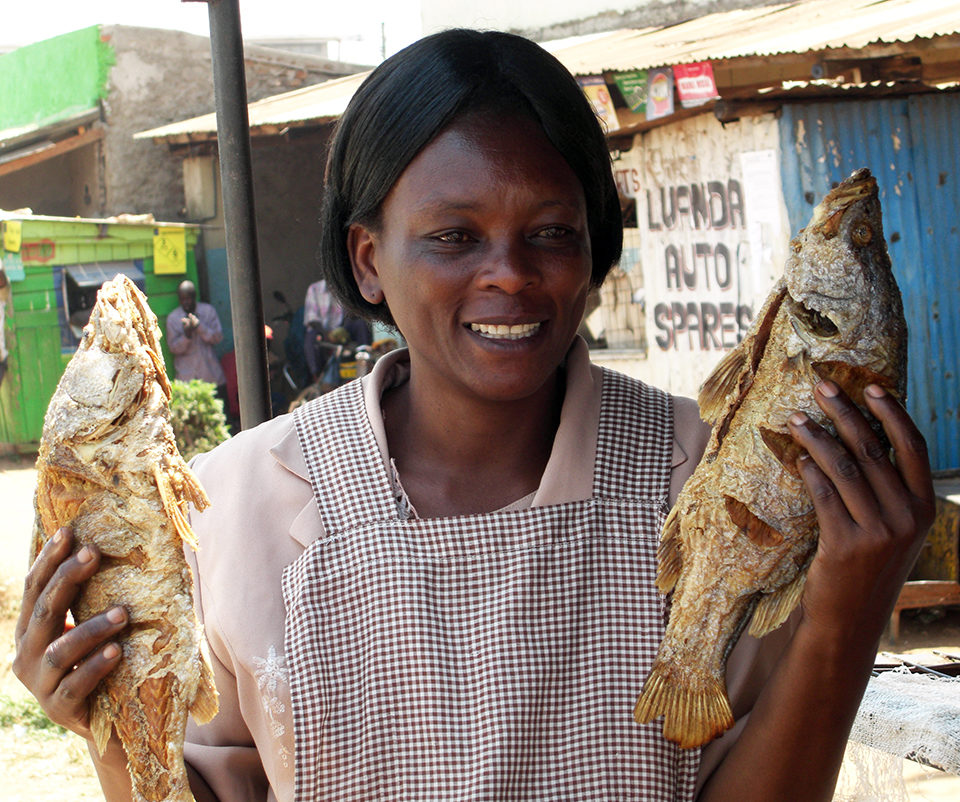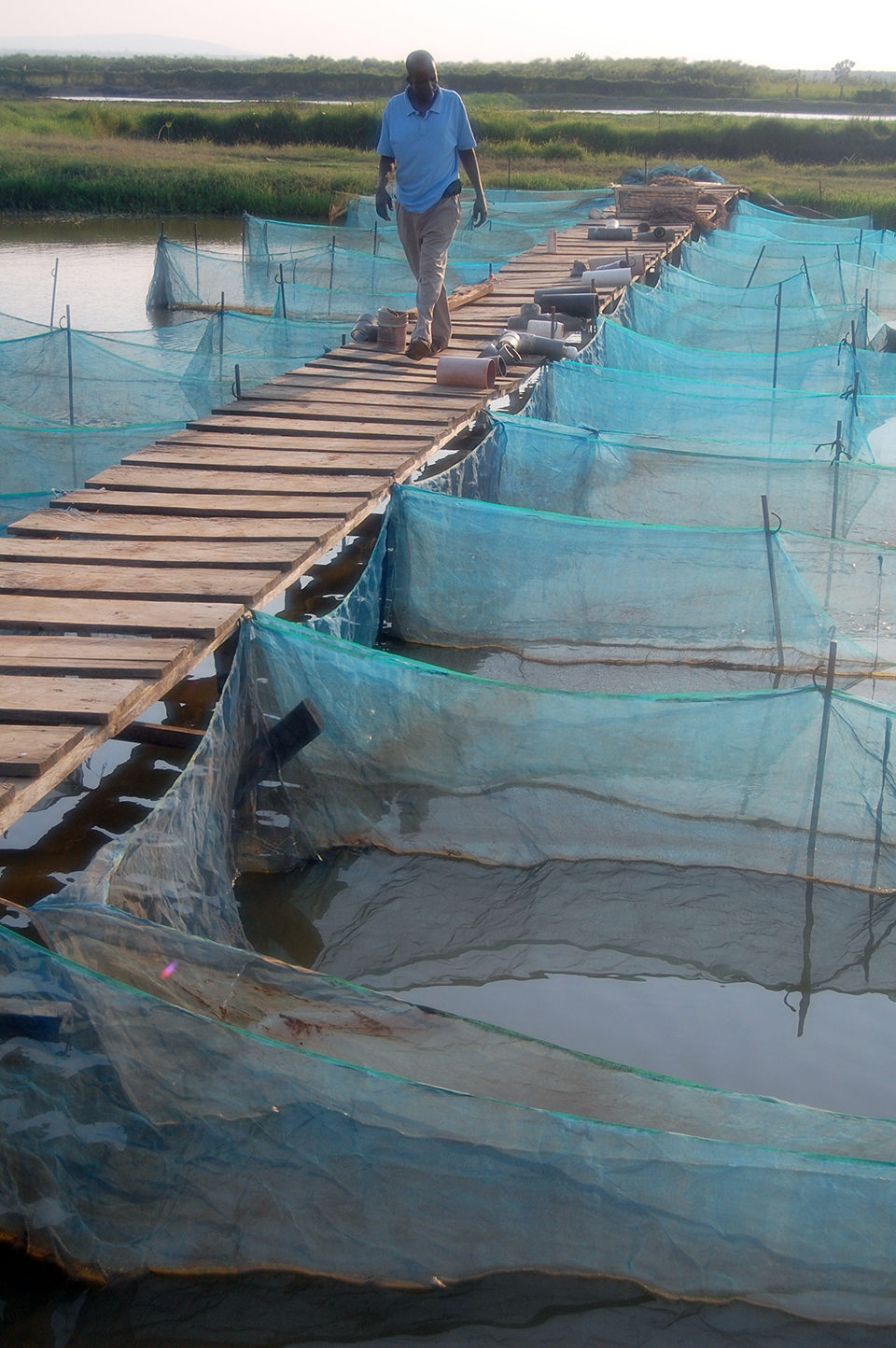Women and young people prospering under new initiative

Like many countries attempting to navigate the world’s current financial doldrums, Kenya recently launched an economic stimulus program. But Kenya’s approach includes a bold move to help the country’s small-scale farmers literally dig themselves out of poverty – by excavating tens of thousands of holes in the ground. Fish ponds, that is.
In a move that generated both enthusiasm and caution, the stimulus program has spent $16 million since January 2010 to increase the country’s aquaculture production 15-fold.
Aquaculture stimulus
Crafted in late 2009 by government fisheries officials, researchers and educators, the two-phased aquaculture component of the stimulus package is ambitious. Phase 1, begun in January of 2010, ramped up Kenya’s aquaculture output several notches by funding the construction of 28,000 fish ponds, boosting farm fish production from 1,000 metric tons (MT) in 2008 to an estimated 8,000 MT in 2010 and 15,000 MT in 2012.
Phase 2 of the stimulus program began at the end of 2010 with an additional $37.5 million of dedicated funds for the aquaculture sector and a promise to increase the number of fish ponds to 48,000 countrywide. This is rapid growth for a country with only 7,500 ponds before the stimulus.
Food and cash
For Kenya’s fisheries officials, it’s not so much about how many fish are produced as who produces them. Officials see these new ponds as homes for millions of tilapia, catfish and ornamental fish that can put food on the table and money in the pockets of some of the country’s poorest farmers.
“I’m proud to say that fish farming has made me what I am today,” said George Ambuli, chairman of a successful fish-farming cooperative in a small village near Lake Victoria. “I eat fish, I have a cell phone in my pocket, and I am paying the school fees for my 9-year-old daughter – all with my fish money.”
Historically the freshwater capture fish industry of Lake Victoria and other lakes has been a modest but important source of jobs and food security for Kenya. But government officials worry about the steady decline in natural fish stocks and the increasing demand for fish. They are counting on aquaculture to relieve the pressure on these overstretched fisheries and supply a more sustainable source of protein – and cash – for Kenyans.

Historical partnership
A key partner in Kenya’s increasing reliance on aquaculture is the Aquaculture & Fisheries Collaborative Research Support Program (AquaFish CRSP) funded by the United States Agency for International Development. AquaFish CRSP has been helping transform aquaculture in Kenya since 1997.
Dr. Charles Ngugi of Kenyatta University, the in-country investigator for CRSP, has been a key player in getting information to the farmers through on-the-ground training. “Aquaculture in Kenya is a unique example that the rest of Africa can borrow from,” he said. “We have a close relationship among research, education and extension.”
CRSP has championed on-farm trials and workshop training to deliver information directly to the farmers in ways the farmers can understand and use. Ngugi credits CRSP with training farmers not only in the management of ponds and fish, but also providing them with tools critical for their financial success, including accurate record keeping, enterprise budgeting and methods of obtaining credit.
Got fish?
If you have a pond, you need fish, and Kenya’s new pond owners are looking to the government to supply them. In less than a year, the demand for fingerlings in Kenya grew from 1 million to a whopping 28 million. Demand is outstripping supply, with many farmers still waiting for their new ponds to be stocked. To solve the problem, the government is leaning heavily on private industry.
Enos Mac’Were is the soft-spoken aquaculture manager at Dominion Farms, a large, diversified private farm in western Kenya. Mac’Were, whose master’s degree thesis work at Moi University was funded through CRSP, has felt the pressure from the demands created by the economic stimulus program. He said the government asked his company to raise its original commitment of half a million fingerlings a month to 2 million fish monthly.
Observers agree the government must go beyond the private sector to supply sufficient numbers of these critical juvenile fish. In response, the Department of Fisheries has identified over 30 hatcheries that could be revamped to meet the demand.
Other issues
The enormous leap in fish farming brought on by the economic stimulus program has presented other challenges, as well. Fisheries officials admittedly were not well prepared when the full three years’ worth of aquaculture stimulus money came all at once.
“We were going into uncharted waters and didn’t anticipate some of the things we’re facing now,” said Kenya Director of Fisheries Godfrey Monor. In the rush to spend the money, fish ponds were not always well thought out, and more than a few were built in inappropriate locations.
The sudden enthusiasm for aquaculture had another unexpected side effect. “Everyone is jumping on the boat,” Monor said. “For each farmer funded by the stimulus program, there are three ponds being put up by non-funded farmers. They are all looking to us for guidance and help.”
Turf to surf
The success of Kenyan aquaculture ultimately depends on consumer demand for fish. In a country that loves its nyami choma, a roasted meat barbecue, it’s not easy to move the population from turf to surf.
“We had cultural challenges in some communities that were not fish eaters,” Monor said. “But we’ve overcome that by the sensitization of the farmers and with communication.”
Although the perception persists that farmed fish are not as good as wild-caught fish, Monor is confident that in time, 50 percent of the fish consumed in Kenya will be farm-grown. Market research has revealed Kenyans’ preference for attractive, plate-sized tilapia fit for one serving.
Fisheries officials plan to put additional marketing structures into place. Extension officers now regularly include a value-added component in their training workshops, encouraging farmers to gut, scale and dry their tilapia for market. Meanwhile, the government is building 80 small refrigeration centers around Kenya to encourage small farmers to move beyond their neighborhood markets.
Training is key
Government officials, aquaculture researchers and fisheries extension officers all agree that the explosive growth of aquaculture in Kenya requires a massive surge in training programs for these new fish farmers. Government involvement in the program is set to phase out over the next 18 months, and this could leave some farmers stranded if they rely totally on the government stimulus money and don’t master the art of fish farming.
“Pond construction is easy – it’s the management that’s critical,” said Wilson Maina, acting director of aquaculture in Kenya. The key, Maina said, is to go beyond pond construction and train new pond owners in pond management and marketing.
To meet this super-sized training challenge, the Kenyan government will continue to build on the work done by CRSP. Fisheries Director Monor noted that many of those who authored the aquaculture stimulus component were educated with CRSP support, and newly funded ponds are being constructed under the supervision of AquaFish CRSP-trained fisheries officers.

Rising tide lifts all boats
Two underprivileged groups, Kenya’s women and young people, are prospering under the new aquaculture initiative. While fish ponds continue to be owned almost exclusively by men, women are increasingly involved in all phases of fish farming, including feeding, fertilization, predator control and value-added post-production techniques.
“Women have started to play a very big economic role, because they know how to work together as a group,” African Union program leader Gitonga said. Women also now predominate in the processing and marketing sectors.
Kenya’s vastly underemployed youths are also reaping benefits. They actually do the pond construction and are empowered with the knowledge, providing practical expertise in the extension service.
In affecting a broad spectrum of the country’s economy and its people, the economic stimulus program is changing the landscape of aquaculture in Kenya.
“We are really moving forward, and nothing will hold us back,” Monor said. “This program will be a success, and if you come here next year, you’ll see a big difference in aquaculture in this country.”
(Editor’s Note: This article was originally published in the July/August 2011 print edition of the Global Aquaculture Advocate.)
Author
-
Jeff Hino
Lifelong Learning Leader
Oregon State University Extended Campus & Extension
Experiment Station Communications
4943 The Valley Library
Corvallis, Oregon 97331 USA
Related Posts

Intelligence
Competition across fish species in E.U.
In Europe, most frozen white fish fillets operate in an undifferentiated market. Although differences in quality and processing affect pricing, there is also competition across species and exporting countries. Analysis showed that prices for tilapia from the leading exporter China were not affected by any competitor, but pricing for tilapia from other countries was highly related. Low Pangasius prices affected the market share of tilapia, which may help explain why Pangasius is a most popular fish in the European Union.

Innovation & Investment
Investing in Africa’s aquaculture future, part 1
What is the future that Africa wants? Views on how to grow aquaculture on the continent vary widely, but no one disputes the notion that food security, food safety, income generation and job creation all stand to benefit.

Innovation & Investment
Investing in Africa’s aquaculture future, part 2
Africa offers innumerable opportunities and a raft of challenges for developing a modernized aquaculture industry. Investors are interested, and pursuing with cautious optimism.

Responsibility
Native shrimp cultured in Cameroon
A cooperative project established to study the small-scale culture of the native shrimp Farfantepenaeus notialis in Cameroon aims to develop family- and community-level production in the region.


